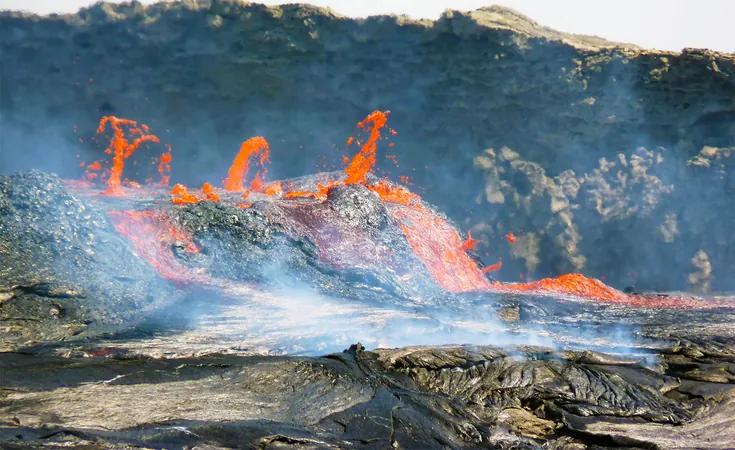
Explosive Discovery: Fresh Lava from Earth's Mantle Surfaces as New Ocean Forms
2025-06-29
Author: Wei
A Fiery Revelation Beneath Our Feet
Beneath the Earth's surface lies a mysterious realm known as the mantle, where heat builds and rock rises toward the crust. This process, known as mantle upwelling, is pivotal in the creation of volcanoes, the tearing apart of continents, and the birth of new ocean basins.
Afar Depression: Nature's Geological Laboratory
In East Africa, the Afar Depression stands out as one of the few regions where three tectonic plate boundaries converge: the Main Ethiopian Rift, the Red Sea Rift, and the Gulf of Aden Rift. Scientists have long speculated about a mantle upwelling in this area, but the specifics of its shape, composition, and interaction with surface tectonics remained largely a mystery.
Unlocking Secrets Through Lava Analysis
Recent groundbreaking research led by the University of Southampton analyzed lava samples from over 130 young volcanoes in the Afar region, shedding light on this enigmatic upwelling. The findings revealed a complex and asymmetrical structure composed of multiple plumes and varied hot mantle materials, resembling a patchwork rather than a simple stream of lava.
Emma Watts, the lead author of the study, remarked, "We discovered that the mantle under Afar is not stationary or uniform; it pulses with unique chemical signatures. These rising pulses of partially molten rock are guided by the rifting tectonic plates above." As these plates stretch and thin, they allow hot material to rise more easily, hastening the formation of a new ocean.
The Heartbeat of the Earth
Co-author Tom Gernon likened the pulsating mantle to a heartbeat, stating, "The chemical striping indicates a pulsing plume that behaves differently based on the thickness and movement of the tectonic plates above it." This dynamic interaction means that in quickly pulling areas like the Red Sea Rift, mantle flow is more focused and rapid, while in slower regions it becomes more dispersed.
The Tectonic Influence on Lava Flow
The research reshapes our understanding of how continents fracture by linking mantle chemistry with plate dynamics. Co-author Derek Keir emphasized that the evolution of deep mantle upwellings is inherently connected to the movements of the plates overhead, influencing volcanic activity and the process of continental breakup.
The observed plume is gradually eroding the lithosphere—the Earth's tough outer shell—thinning it to as little as 15 kilometers in certain regions. This thinning, combined with the stretching caused by tectonic movements, leads to frequent volcanic eruptions. As a result, vast lava flows cover large areas of Ethiopia and seismic swarms signal the formation of new crust. Ultimately, researchers predict that seawater will flood in, separating the Horn of Africa from the mainland, similar to how the Atlantic Ocean formed between Europe and North America.
A Broader Impact on Earth’s History
The implications of understanding the Afar plume extend beyond local geology. Large igneous provinces, like the one that formed Northern Ireland’s Giant’s Causeway 60 million years ago, have been linked to significant climatic shifts due to their massive CO2 and SO2 emissions, potentially even triggering mass extinctions. By decoding the rhythm of the Afar plume, scientists hope to connect current geological phenomena with historical volcanic bursts and environmental upheavals.
Peering Into Earth’s Depths
Future research aims to map mantle flow beneath thin tectonic plates and understand how it directs volcanic activity. Keir stated, "Our findings show that deep mantle upwellings can flow beneath tectonic plates, concentrating volcanic activity where the crust is thinnest." This collaborative research effort highlights the importance of integrating various scientific techniques to piece together the complex puzzle of Earth’s subterranean processes.
In essence, the study reveals that mantle upwellings are not isolated features; rather, they are dynamically influenced by the movements of the tectonic plates above them. For now, scientists can literally feel these mantle pulses beneath Ethiopia—a rhythmic reminder of powerful geological forces at play, slowly unraveling a massive continent and sketching the outlines of an impending ocean.
The study has been published in the prestigious journal Nature, marking a significant advance in our understanding of Earth’s geological dynamics.



 Brasil (PT)
Brasil (PT)
 Canada (EN)
Canada (EN)
 Chile (ES)
Chile (ES)
 Česko (CS)
Česko (CS)
 대한민국 (KO)
대한민국 (KO)
 España (ES)
España (ES)
 France (FR)
France (FR)
 Hong Kong (EN)
Hong Kong (EN)
 Italia (IT)
Italia (IT)
 日本 (JA)
日本 (JA)
 Magyarország (HU)
Magyarország (HU)
 Norge (NO)
Norge (NO)
 Polska (PL)
Polska (PL)
 Schweiz (DE)
Schweiz (DE)
 Singapore (EN)
Singapore (EN)
 Sverige (SV)
Sverige (SV)
 Suomi (FI)
Suomi (FI)
 Türkiye (TR)
Türkiye (TR)
 الإمارات العربية المتحدة (AR)
الإمارات العربية المتحدة (AR)